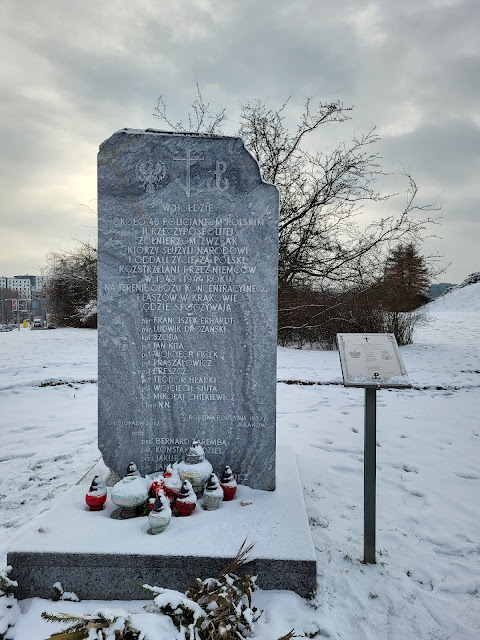12 listopada 1943 roku wyrokiem niemieckiego sądu doraźnego SS i Policji w Krakowie, na terenie obozu koncentracyjnego KL Plaszow, wykonano karę śmierci przez rozstrzelanie na sześciu funkcjonariuszach Policji Polskiej Generalnego Gubernatorstwa dystryktu Krakau, oskarżonych o przynależność do zbrojnego polskiego podziemia (członków Państwowego Korpusu Bezpieczeństwa, ZWZ/AK) i działalność konspiracyjną. To nie była jedyna egzekucja dokonana na „granatowych policjantach”. W okresie od lutego 1943 roku do sierpnia 1944 roku, na obszarze tego dystryktu aresztowano kilkudziesięciu „policjantów granatowych”. Więźniów kierowano na śledztwo do siedziby gestapo w Domu Śląskim przy ulicy Pomorskiej 2. Następnie wywożono ich do obozu koncentracyjnego w Płaszowie, gdzie jako skazanych w parodii procesu przez policyjny sąd doraźny na egzekucję, rozstrzeliwano przed niemieckim plutonem egzekucyjnym. Na terenie KL Plaszow rozstrzelano ich około 40 w kilku zbiorowych i w kilkunastu pojedynczych egzekucjach. Nie było to jedyne miejsce egzekucji na terenie Krakowa czy Małopolski, gdzie wykonywano wyroki śmierci na funkcjonariuszach Policji Polskiej Generalnego Gubernatorstwa oskarżonych o działalność konspiracyjną. Do takich miejsc zaliczał się Fort Krzesławice oraz obszar Puszczy Niepołomickiej.
On November 12, 1943, by the judgment of the German summary court of the SS and Police in Kraków, on the premises of the KL Plaszow concentration camp, six officers of the Polish Police of the General Government of the Krakau District, accused of belonging to the armed Polish underground (members of the State Security Corps, ZWZ), were executed by shooting. /AK) and conspiratorial activities. This was not the only execution of the "blue policemen". In the period from February 1943 to August 1944, several dozen "blue policemen" were arrested in this district. The prisoners were sent for investigation to the Gestapo headquarters in the Silesian House at 2 Pomorska Street. Then they were taken to the concentration camp in Płaszów, where, as those sentenced to execution in a parody of a trial by a police summary court, they were shot in front of a German firing squad. In KL Plaszów, about 40 of them were shot in several collective and a dozen or so individual executions. It was not the only place of execution in Krakow or Lesser Poland, where death sentences were carried out on officers of the Polish Police of the General Government accused of conspiratorial activities. Such places included Fort Krzesławice and the Niepołomicka Forest area.
Am 12. November 1943 wurden durch das Urteil des Deutschen SS- und Polizeigerichts in Krakau auf dem Gelände des Konzentrationslagers KL Plaszow sechs Beamte der polnischen Polizei des Generalgouvernements des Bezirks Krakau wegen Zugehörigkeit angeklagt an den bewaffneten polnischen Untergrund (Angehörige des Staatssicherheitskorps, ZWZ), wurden durch Erschießen hingerichtet. /AK) und konspirative Aktivitäten. Dies war nicht die einzige Hinrichtung der „blauen Polizisten“. In der Zeit von Februar 1943 bis August 1944 wurden in diesem Bezirk mehrere Dutzend „blaue Polizisten“ verhaftet. Die Gefangenen wurden zur Untersuchung in das Gestapo-Hauptquartier im Schlesischen Haus in der Pomorska-Straße 2 geschickt. Anschließend wurden sie in das Konzentrationslager in Płaszów gebracht, wo sie, wie diejenigen, die in einer Parodie auf einen Prozess durch ein Polizei-Schnellgericht zur Hinrichtung verurteilt wurden, dort untergebracht wurden wurden vor den Augen eines deutschen Erschießungskommandos erschossen. Im KL Plaszów wurden etwa 40 von ihnen in mehreren Kollektiv- und etwa einem Dutzend Einzelhinrichtungen erschossen. Es war nicht der einzige Hinrichtungsort in Krakau oder Kleinpolen, an dem Todesurteile gegen Beamte der polnischen Polizei des Generalgouvernements vollstreckt wurden, denen konspirative Aktivitäten vorgeworfen wurden. Zu diesen Orten gehörten die Festung Krzesławice und das Gebiet des Niepołomicka-Waldes.





Brak komentarzy:
Prześlij komentarz